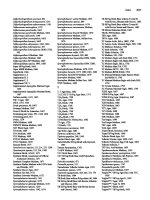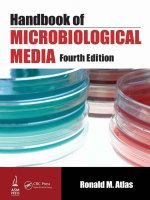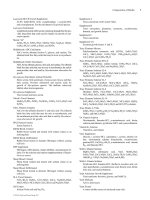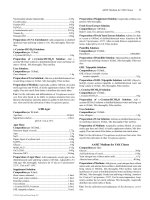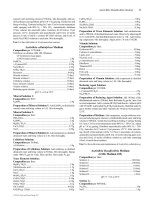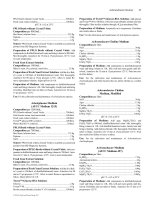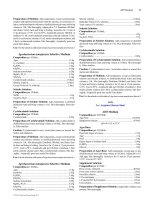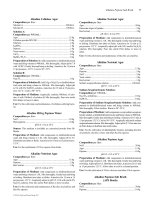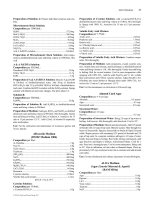Handbook of Microbiological Media, Fourth Edition part 68 pdf
Bạn đang xem bản rút gọn của tài liệu. Xem và tải ngay bản đầy đủ của tài liệu tại đây (225.8 KB, 10 trang )
Falcivibrio Medium 665
Eugonic HiVeg Broth
Composition
per liter:
Plant hydrolysate 15.0g
Glucose 5.0g
Papaic digest of soybean meal 5.0g
NaCl 4.0g
L
-Cystine 0.2g
Na
2
SO
3
0.2g
Sheep blood, defibrinated 50.0mL
pH 7.0 ± 2.0 at 25°C
Source:
This medium, without blood, is available as a premixed pow-
der from HiMedia.
Preparation of Medium:
Add components, except blood, to dis-
tilled/deionized water and bring volume to 950.0mL. Mix thoroughly.
Gently heat and bring to boiling. Autoclave for 15 min at 15 psi pres-
sure–121°C. Cool to 50°C. Aseptically add 50.0mL of sterile defibri-
nated blood. Mix thoroughly. Dispense into sterile tubes or flasks.
Use:
For the cultivation and maintenance of a variety of fastidious
microorganisms, e.g., Brucella, Haemophilus, Neisseria, Pasteurella,
and Lactobacillus species.
EVA Broth
See: Ethyl Violet Azide Broth
Exiguobacterium Medium
Composition
per liter:
Beef extract 10.0g
Peptone 10.0g
NaCl 5.0g
Glucose 5.0g
Yeast extract 3.0g
pH 8.0 ± 0.2 at 25°C
Preparation of Medium:
Add components to distilled/deionized
water and bring volume to 1.0L. Mix thoroughly. Adjust pH to 8.0. Dis-
tribute into tubes or flasks. Autoclave for 15 min at 15 psi pressure–
121°C.
Use:
For the cultivation and maintenance of Exiguobacterium auran-
tiacum.
Extracted Hay Medium
Composition
: Hay or grass 50.0g
Preparation of Medium:
Add hay or grass to 1.0L of distilled/deion-
ized water. Gently heat and bring to boiling. Continue boiling for 30 min.
Rinse with cold water twice. Add 1.0L of distilled/deionized water, boil
30 min, and rinse. Repeat this process at least five times. Dry the extract-
ed hay or grass. Add 10–30 blades of extracted hay or grass to a large test
tube. Autoclave for 15 min at 15 psi pressure–121°C.
Use:
For the isolation and cultivation of Beggiatoa species and myx-
otrophic Thiothrix species.
EYGA Agar
Composition
per liter:
Agar 12.0g
K
2
HPO
4
1.1g
Glucose 1.0g
Yeast extract 1.0g
KH
2
PO
4
0.86g
(NH
4
)
2
SO
4
0.5g
MgSO
4
·7H
2
O 0.2g
NaCl 0.1g
CaCl
2
0.025g
Vitamin B
12
2.0μg
EDTA/trace elements mix 3.0mL
pH 6.8 ± 0.2 at 25°C
EDTA/Trace Elements Mix:
Composition
per 600.0mL:
EDTA 5.0g
ZnSO
4
·7H
2
O 2.2g
MnSO
4
·4H
2
O 0.57g
FeSO
4
·7H
2
O 0.50g
CoCl
2
·6H
2
O 0.161g
CuSO
4
·5H
2
O 0.157g
Na
2
MoO
4
·2H
2
O 0.151g
Preparation of EDTA/Trace Elements Mix:
Add components
to distilled/deionized water and bring volume to 600.0mL. Mix thor-
oughly.
Preparation of Medium:
Add components to distilled/deionized
water and bring volume to 1.0L. Mix thoroughly. Adjust pH to 6.8.
Distribute into tubes or flasks. Autoclave for 15 min at 15 psi pressure–
121°C.
Use:
For the cultivation and maintenance of
Arthrobacter species.
EYS Agar
See: Emerson’s Yeast Starch Agar
FAA Alternative Selective
See: Fastidious Anaerobe Agar, Alternative Selective
FAA Alternative Selective with Neomycin,
Vancomycin, and Josamycin
See: Fastidious Anaerobe Agar, Alternative Selective with
Neomycin, Vancomycin, and Josamycin
FAA Selective with Neomycin and Vancomycin
See: Fastidious Anaerobe Agar, Selective with Neomycin
and Vancomycin
Falcivibrio Medium
Composition
per liter:
Pancreatic digest of casein 10.0g
Gelatin peptone 10.0g
NaCl 5.0g
Yeast extract 5.0g
Glucose 1.0g
L-
Arginine 1.0g
Sodium pyruvate 1.0g
Cysteine 0.3g
Hemin 5.0mg
Resazurin 1.0mg
Menadione 0.5mg
Serum, equine, bovine, or ovine 50.0mL
pH 7.1 ± 0.2 at 25°C
Preparation of Medium:
Prepare medium under 100% N
2
. Add
components, except serum, to distilled/deionized water and bring vol-
ume to 950.0mL. Mix thoroughly. Autoclave for 15 min at 15 psi pres-
sure–121°C. Aseptically and anaerobically add 50.0mL of sterile
serum. Mix thoroughly. Aseptically and anaerobically distribute into
sterile tubes or flasks.
© 2010 by Taylor and Francis Group, LLC
666 Fastidious Anaerobe Agar
Use: For the cultivation and maintenance of Falcivibrio grandis and
Falcivibrio vaginalis.
Fastidious Anaerobe Agar
(FAA)
Composition per liter:
Peptone 23.0g
Agar 12.0g
NaCl 5.0g
Glucose 1.0g
L-Arginine 1.0g
Sodium pyruvate 1.0g
Soluble starch 1.0g
L-Cysteine·HCl·H
2
O 0.5g
Sodium succinate 0.5g
NaHCO
3
0.4g
Na
4
P
2
O
7
·10H
2
O 0.25g
Sheep blood, defibrinated 50.0mL
Hemin solution 1.0mL
Vitamin K
1
solution 0.1mL
pH 7.2 ± 0.2 at 25°C
Vitamin K
1
Solution:
Composition
per 100.0mL:
Vitamin K
1
1.0g
Ethanol 99.0mL
Preparation of Vitamin K
1
Solution: Add vitamin K
1
to 99.0mL
of absolute ethanol. Mix thoroughly.
Hemin Solution:
Composition
per 100.0mL:
Hemin 1.0g
NaOH (1N solution) 20.0mL
Preparation of Hemin Solution: Add hemin to 20.0mL of 1N
NaOH solution. Mix thoroughly. Bring volume to 100.0mL with dis-
tilled/deionized water.
Preparation of Medium: Add components, except defibrinated
sheep blood, to distilled/deionized water and bring volume to
950.0mL. Mix thoroughly. Gently heat and bring to boiling. Autoclave
for 15 min at 15 psi pressure–121°C. Cool to 45°–50°C. Aseptically
add 50.0mL of sterile defibrinated sheep blood. Mix thoroughly. Pour
into sterile Petri dishes or distribute into sterile tubes.
Use: For the cultivation of a variety of fastidious anaerobes from clin-
ical and nonclinical specimens.
Fastidious Anaerobe Agar, Alternative Selective
(FAA Alternative Selective)
Composition per liter:
Peptone 23.0g
Agar 12.0g
NaCl 5.0g
Glucose 1.0g
L-Arginine 1.0g
Sodium pyruvate 1.0g
Soluble starch 1.0g
L-Cysteine·HCl·H
2
O 0.5g
Sodium succinate 0.5g
NaHCO
3
0.4g
Na
4
P
2
O
7
·10H
2
O 0.25g
Sheep blood, defibrinated 50.0mL
Hemin solution 1.0mL
Vitamin K
1
solution 0.1mL
pH 7.2 ± 0.2 at 25°C
Vitamin K
1
Solution:
Composition
per 100.0mL:
Vitamin K
1
1.0g
Ethanol 99.0mL
Preparation of Vitamin K
1
Solution: Add vitamin K
1
to 99.0mL
of absolute ethanol. Mix thoroughly.
Hemin Solution:
Composition
per 100.0mL:
Hemin 1.0g
NaOH (1N solution) 20.0mL
Preparation of Hemin Solution: Add hemin to 20.0mL of 1N
NaOH solution. Mix thoroughly. Bring volume to 100.0mL with dis-
tilled/deionized water.
Preparation of Medium: Add components, except defibrinated
sheep blood, to distilled/deionized water and bring volume to
950.0mL. Mix thoroughly. Gently heat and bring to boiling. Autoclave
for 15 min at 15 psi pressure–121°C. Cool to 45°–50°C. Aseptically
add 50.0mL of sterile defibrinated sheep blood. Mix thoroughly. Pour
into sterile Petri dishes or distribute into sterile tubes.
Use: For the cultivation of a variety of fastidious anaerobes from clin-
ical and nonclinical specimens.
Fastidious Anaerobe Agar, Alternative Selective with
Neomycin, Vancomycin, and Josamycin
(FAA Alternative Selective Medium
with Neomycin, Vancomycin, and Josamycin)
Composition per liter:
Peptone 23.0g
Agar 12.0g
NaCl 5.0g
Glucose 1.0g
L-Arginine 1.0g
Sodium pyruvate 1.0g
Soluble starch 1.0g
L-Cysteine·HCl·H
2
O 0.5g
Sodium succinate 0.5g
NaHCO
3
0.4g
Na
4
P
2
O
7
·10H
2
O 0.25g
Neomycin 0.1g
Sheep blood, defibrinated 50.0mL
Vancomycin solution 10.0mL
Josamycin solution 10.0mL
Hemin solution 1.0mL
Vitamin K
1
solution 0.1mL
pH 7.2 ± 0.2 at 25°C
Vitamin K
1
Solution:
Composition
per 100.0mL:
Vitamin K
1
1.0g
Ethanol 99.0mL
Preparation of Vitamin K
1
Solution: Add vitamin K
1
to 99.0mL
of absolute ethanol. Mix thoroughly.
Hemin Solution:
Composition
per 100.0mL:
Hemin 1.0g
NaOH (1N solution) 20.0mL
© 2010 by Taylor and Francis Group, LLC
Fastidious Anaerobe Agar, Selective with Neomycin and Vancomycin 667
Preparation of Hemin Solution: Add hemin to 20.0mL of 1N
NaOH solution. Mix thoroughly. Bring volume to 100.0mL with dis-
tilled/deionized water.
Vancomycin Solution:
Composition
per 10.0mL:
Vancomycin 5.0mg
Preparation of Vancomycin Solution: Add vancomycin to dis-
tilled/deionized water and bring volume to 10.0mL. Mix thoroughly.
Filter sterilize.
Josamycin Solution:
Composition
per 10.0mL:
Josamycin 3.0mg
Preparation of Josamycin Solution: Add josamycin to distilled/
deionized water and bring volume to 10.0mL. Mix thoroughly. Filter
sterilize.
Preparation of Medium: Add components, except defibrinated
sheep blood, vancomycin solution, and josamycin solution, to distilled/
deionized water and bring volume to 930.0mL. Mix thoroughly. Gently
heat and bring to boiling. Autoclave for 15 min at 15 psi pressure–
121°C. Cool to 45°–50°C. Aseptically add 50.0mL of sterile defibri-
nated sheep blood, 10.0mL vancomycin solution, and 10.0mL of
josamycin solution. Mix thoroughly. Pour into sterile Petri dishes or
distribute into sterile tubes.
Use: For the selective cultivation of Fusobacterium species from clin-
ical and nonclinical specimens.
Fastidious Anaerobe Agar, Selective
(FAA Selective)
Composition per liter:
Peptone 23.0g
Agar 12.0g
NaCl 5.0g
Glucose 1.0g
L-Arginine 1.0g
Sodium pyruvate 1.0g
Soluble starch 1.0g
L-Cysteine·HCl·H
2
O 0.5g
Sodium succinate 0.5g
NaHCO
3
0.4g
Na
4
P
2
O
7
·10H
2
O 0.25g
Sheep blood, defibrinated 50.0mL
Hemin solution 1.0mL
Vitamin K
1
solution 0.1mL
pH 7.2 ± 0.2 at 25°C
Vitamin K
1
Solution:
Composition
per 100.0mL:
Vitamin K
1
1.0g
Ethanol 99.0mL
Preparation of Vitamin K
1
Solution: Add vitamin K
1
to 99.0mL
of absolute ethanol. Mix thoroughly.
Hemin Solution:
Composition
per 100.0mL:
Hemin 1.0g
NaOH (1N solution) 20.0mL
Preparation of Hemin Solution: Add hemin to 20.0mL of 1N
NaOH solution. Mix thoroughly. Bring volume to 100.0mL with dis-
tilled/deionized water.
Preparation of Medium: Add components, except defibrinated
sheep blood, to distilled/deionized water and bring volume to
950.0mL. Mix thoroughly. Gently heat and bring to boiling. Autoclave
for 15 min at 15 psi pressure–121°C. Cool to 45°–50°C. Aseptically
add 50.0mL of sterile defibrinated sheep blood. Mix thoroughly. Pour
into sterile Petri dishes or distribute into sterile tubes.
Use: For the cultivation of a variety of fastidious anaerobes from clin-
ical and nonclinical specimens.
Fastidious Anaerobe Agar, Selective
with Neomycin and Vancomycin
(FAA Selective with Neomycin and Vancomycin)
Composition per liter:
Peptone 23.0g
Agar 12.0g
NaCl 5.0g
Glucose 1.0g
L-Arginine 1.0g
Sodium pyruvate 1.0g
Soluble starch 1.0g
L-Cysteine·HCl·H
2
O 0.5g
Sodium succinate 0.5g
NaHCO
3
0.4g
Na
4
P
2
O
7
·10H
2
O 0.25g
Neomycin 0.1g
Sheep blood, defibrinated 50.0mL
Vancomycin solution 10.0mL
Hemin solution 1.0mL
Vitamin K
1
solution 0.1mL
pH 7.2 ± 0.2 at 25°C
Vitamin K
1
Solution:
Composition
per 100.0mL:
Vitamin K
1
1.0g
Ethanol 99.0mL
Preparation of Vitamin K
1
Solution: Add vitamin K
1
to 99.0mL
of absolute ethanol. Mix thoroughly.
Hemin Solution:
Composition
per 100.0mL:
Hemin 1.0g
NaOH (1N solution) 20.0mL
Preparation of Hemin Solution: Add hemin to 20.0mL of 1N
NaOH solution. Mix thoroughly. Bring volume to 100.0mL with dis-
tilled/deionized water.
Vancomycin Solution:
Composition
per 10.0mL:
Vancomycin 7.5mg
Preparation of Vancomycin Solution: Add vancomycin to dis-
tilled/deionized water and bring volume to 10.0mL. Mix thoroughly.
Filter sterilize.
Preparation of Medium: Add components, except defibrinated
sheep blood and vancomycin solution, to distilled/deionized water and
bring volume to 940.0mL. Mix thoroughly. Gently heat and bring to
boiling. Autoclave for 15 min at 15 psi pressure–121°C. Cool to 45°–
50°C. Aseptically add 50.0mL of sterile defibrinated sheep blood and
10.0mL of vancomycin solution. Mix thoroughly. Pour into sterile Pe-
tri dishes or distribute into sterile tubes.
Use: For the selective cultivation of Fusobacterium species from clin-
ical and nonclinical specimens.
© 2010 by Taylor and Francis Group, LLC
668 Fay and Barry Medium
Fay and Barry Medium
Composition per liter:
Amino acid 10.0g
Peptone 5.0g
Yeast extract 3.0g
Bromcresol Purple solution 5.0mL
pH 5.5 ± 0.2 at 25°C
Bromcresol Purple Solution:
Composition
per 100.0mL:
Bromcresol Purple 0.2g
Ethanol 50.0mL
Preparation of Bromcresol Purple Solution: Add Bromcresol
Purple to 50.0mL of absolute ethanol. Add distilled/deionized water
and bring volume to 100.0mL. Mix thoroughly.
Preparation of Medium: Add components to distilled/deionized
water and bring volume to 1.0L. The amino acid may be
L-arginine, L-
ornithine, or L-lysine, depending on which amino acid decarboxylase
activity is being measured. Mix thoroughly. Distribute into tubes or
flasks. Autoclave for 15 min at 15 psi pressure–121°C.
Use: For the determination of decarboxylase activities of Aeromonas
species.
Faybitch’s Sucrose Gelatin Agar
Composition per liter:
Sucrose 100.0g
Gelatin 15.0g
Agar 10.0g
Preparation of Medium: Add components to distilled/deionized
water and bring volume to 1.0L. Mix thoroughly. Gently heat and bring
to boiling. Distribute into tubes or flasks. Autoclave for 15 min at 15
psi pressure–121°C. Pour into sterile Petri dishes or leave in tubes.
Use: For the growth of microbial cultures that are to be lyophilized.
FB Medium
(DSMZ Medium 980)
Composition per liter:
NH
4
Cl 0.54g
MgCl
2
·6H
2
O 0.2g
CaCl
2
·2H
2
O 0.15g
KH
2
PO
4
0.14g
Resazurin 0.5mg
NaHCO
3
solution 10.0mL
Yeast extract solution 10.0mL
Na-crotonate solution 10.0mL
Cysteine solution 10.0mL
Na
2
S·9H
2
O solution 10.0mL
Vitamin solution 10.0mL
Trace elements solution SL-9 1.0mL
Selenite tungstate solution 1.0mL
pH 7.0 ± 0.2 at 25°C
Na-Crotonate Solution:
Composition
per 10.0mL:
Na-crotonate 0.86g
Preparation of Na-Crotonate Solution: Add Na-crotonate to
distilled/deionized water and bring volume to 10.0mL. Mix thorough-
ly. Sparge with 100% N
2
. Autoclave for 15 min at 15 psi pressure–
121°C.
Cysteine Solution:
Composition
per 10.0mL:
L-Cysteine·HCl·H
2
O 0.25g
Preparation of Cysteine Solution: Add L-cysteine·HCl·H
2
O to
distilled/deionized water and bring volume to 10.0mL. Mix thorough-
ly. Sparge with 100% N
2
. Autoclave for 15 min at 15 psi pressure–
121°C.
Trace Elements Solution SL-9:
Composition
per liter:
MgSO
4
·7H
2
O 3.0g
Nitrilotriacetic acid 1.5g
NaCl 1.0g
MnSO
4
·2H
2
O 0.5g
CoSO
4
·7H
2
O 0.18g
ZnSO
4
·7H
2
O 0.18g
CaCl
2
·2H
2
O 0.1g
FeSO
4
·7H
2
O 0.1g
NiCl
2
·6H
2
O 0.025g
KAl(SO
4
)
2
·12H
2
O 0.02g
H
3
BO
3
0.01g
Na
2
MoO
4
·4H
2
O 0.01g
CuSO
4
·5H
2
O 0.01g
Na
2
SeO
3
·5H
2
O 0.3mg
Preparation of Trace Elements Solution SL-9: Add nitrilotriacetic
acid to 500.0mL of distilled/deionized water. Dissolve by adjusting pH
to 6.5 with KOH. Add remaining components. Add distilled/deionized
water to 1.0L. Mix thoroughly.
Vitamin Solution:
Composition
per liter:
Pyridoxine-HCl 10.0mg
Thiamine-HCl·2H
2
O 5.0mg
Riboflavin 5.0mg
Nicotinic acid 5.0mg
D-Ca-pantothenate 5.0mg
p-Aminobenzoic acid 5.0mg
Lipoic acid 5.0mg
Biotin 2.0mg
Folic acid 2.0mg
Vitamin B
12
0.1mg
Preparation of Vitamin Solution: Add components to distilled/
deionized water and bring volume to 1.0L. Mix thoroughly. Sparge
with 80% H
2
+ 20% CO
2
. Filter sterilize.
Na
2
S·9H
2
O Solution:
Composition per 10.0mL:
Na
2
S·9H
2
O 0.25g
Preparation of Na
2
S·9H
2
O Solution: Add Na
2
S·9H
2
O to dis-
tilled/deionized water and bring volume to 10.0mL. Sparge with N
2
.
Autoclave for 15 min at 15 psi pressure–121°C. Cool to 25°C. Store an-
aerobically.
NaHCO
3
Solution:
Composition
per 10.0mL:
NaHCO
3
2.5g
Preparation of NaHCO
3
Solution: Add NaHCO
3
to distilled/de-
ionized water and bring volume to 10.0mL. Mix thoroughly. Sparge
with 80% N
2
+ 20% CO
2
. Filter sterilize.
Yeast Extract Solution:
Composition
per 10.0mL:
Yeast extract 0.2g
© 2010 by Taylor and Francis Group, LLC
FC Broth 669
Preparation of Yeast Extract Solution: Add yeast extract to dis-
tilled/deionized water and bring volume to 10.0mL. Mix thoroughly.
Sparge with 100% N
2
. Filter sterilize.
Preparation of Medium: Add components, except Na-crotonate
solution, yeast extract solution, cysteine solution, vitamin solution,
NaHCO
3
solution, and Na
2
S·9H
2
O solution, to distilled/deionized wa-
ter and bring volume to 940.0mL. Mix thoroughly. Gently heat and
bring to boiling. Boil for 3 min. Cool to 25°C while sparging with 80%
N
2
+ 20% CO
2
. Distribute to anaerobe tubes or bottles under 80% N
2
+ 20% CO
2
. Autoclave for 15 min at 15 psi pressure–121°C. Aseptical-
ly and anaerobically add per liter of medium, 10.0mL sterile cysteine
solution, 10.0mL sterile Na-crotonate solution, 10.0mL sterile vitamin
solution, 10.0mL sterile yeast extract solution, 10.0mL sterile NaHCO
3
solution, and 10.0mL sterile Na
2
S·9H
2
O solution. Mix thoroughly. The
final pH should be 7.0.
Use: For the cultivation of Sporotomaculum syntrophicum.
FC Agar
(Fecal Coliform Agar)
(m-FC Agar)
(m-Fecal Coliform Agar)
Composition per liter:
Agar 15.0g
Lactose 12.5g
NaCl 5.0g
Proteose peptone No. 3 5.0g
Yeast extract 3.0g
Bile salts 1.5g
Aniline Blue 0.1g
Rosolic acid solution 10.0mL
pH 7.4 ± 0.2 at 25°C
Source: This medium is available as a premixed powder from BD Di-
agnostic Systems.
Rosolic Acid Solution:
Composition
per 100.0mL:
Rosolic acid 1.0g
Preparation of Rosolic Acid Solution: Add rosolic acid to 0.2N
NaOH and bring volume to 100.0L. Mix thoroughly.
Preparation of Medium: Add 10.0mL rosolic acid solution to
950.0mL distilled/deionized water. Mix thoroughly. Add other compo-
nents and bring volume to 1.0L with distilled/deionized water. Mix
thoroughly. Gently heat and bring to boiling with frequent mixing. Do
not autoclave. Pour into sterile Petri dishes or leave in tubes.
Use: For the cultivation of fecal coliform bacteria from waters and the
enumeration of coliform bacteria using the membrane filtration
method.
FC Agar
(Fecal Coliform Agar)
(m-FC Agar)
(m-Fecal Coliform Agar)
Composition per liter:
Agar 15.0g
Lactose 12.5g
Tryptose 10.0g
NaCl 5.0g
Proteose peptone No. 3 5.0g
Yeast extract 3.0g
Bile salts 1.5g
Aniline Blue 0.1g
Rosolic acid solution 10.0mL
pH 7.4 ± 0.2 at 25°C
Rosolic Acid Solution:
Composition
per 100.0mL:
Rosolic acid 1.0g
Preparation of Rosolic Acid Solution: Add rosolic acid to 0.2N
NaOH and bring volume to 100.0L. Mix thoroughly.
Preparation of Medium: Add 10.0mL rosolic acid solution to
950.0mL of distilled/deionized water. Mix thoroughly. Add other com-
ponents and bring volume to 1.0L with distilled/deionized water. Mix
thoroughly. Gently heat and bring to boiling with frequent mixing. Do
not autoclave. Pour into sterile Petri dishes or leave in tubes.
Use: For the cultivation of fecal coliform bacteria from waters and the
enumeration of coliform bacteria using the membrane filtration
method.
FC Broth
(Fecal Coliform Broth)
(m-FC Broth)
(m-Fecal Coliform Broth)
Composition per liter:
Lactose 12.5g
Tryptose 10.0g
NaCl 5.0g
Proteose peptone No. 3 5.0g
Yeast extract 3.0g
Bile salts 1.5g
Aniline Blue 0.1g
Rosolic acid solution 10.0mL
pH 7.4 ± 0.2 at 25°C
Rosolic Acid Solution:
Composition
per 100.0mL:
Rosolic acid 1.0g
Preparation of Rosolic Acid Solution: Add rosolic acid to 0.2N
NaOH and bring volume to 100.0L. Mix thoroughly.
Preparation of Medium: Add 10.0mL of rosolic acid solution to
950.0mL of distilled/deionized water. Mix thoroughly. Add other com-
ponents and bring volume to 1.0L with distilled/deionized water. Mix
thoroughly. Gently heat and bring to boiling with frequent mixing. Do
not autoclave. Pour into sterile Petri dishes or leave in tubes.
Use: For the cultivation of fecal coliform bacteria from waters and the
enumeration of coliform bacteria using the membrane filtration
method.
FC Broth
(Fecal Coliform Broth)
(m-FC Broth)
(m-Fecal Coliform Broth)
Composition per liter:
Lactose 12.5g
NaCl 5.0g
Proteose peptone No. 3 5.0g
Yeast extract 3.0g
Bile salts 1.5g
© 2010 by Taylor and Francis Group, LLC
670 FDA Agar
Aniline Blue 0.1g
Rosolic acid solution 10.0mL
pH 7.4 ± 0.2 at 25°C
Source: This medium is available as a premixed powder from BD Di-
agnostic Systems.
Rosolic Acid Solution:
Composition
per 100.0mL:
Rosolic acid 1.0g
Preparation of Rosolic Acid Solution: Add rosolic acid to 0.2N
NaOH and bring volume to 100.0L. Mix thoroughly.
Preparation of Medium: Add 10.0mL of rosolic acid solution to
950.0mL of distilled/deionized water. Mix thoroughly. Add other com-
ponents and bring volume to 1.0L with distilled/deionized water. Mix
thoroughly. Gently heat and bring to boiling with frequent mixing. Do
not autoclave. Pour into sterile Petri dishes or leave in tubes.
Use: For the cultivation of fecal coliform bacteria from waters and the
enumeration of coliform bacteria using the membrane filtration
method.
FCIC
See: Fecal Coliform Agar, Modified
FDA Agar
(ATCC Medium 182)
(AATCC Bacteriostasis Agar)
(American Association of Textile Chemists
and Colorists Bacteriostasis Agar)
Composition per liter:
Agar 15.0g
Peptic digest of animal tissue 10.0g
Beef extract 5.0g
NaCl 5.0g
pH 6.8 ± 0.1 at 25°C
Source: This medium is available as a premixed powder from BD Di-
agnostic Systems.
Preparation of Medium: Add components to distilled/deionized
water and bring volume to 1.0L. Mix thoroughly. Gently heat and bring
to boiling. Distribute into tubes or flasks. Autoclave for 15 min at 15
psi pressure–121°C. Pour into sterile Petri dishes or leave in tubes.
Use: For testing the antibacterial activities of antiseptics and disinfec-
tants.
FDA Broth
(AATCC Bacteriostasis Broth)
(American Association of Textile
Chemists and Colorists
Bacteriostasis Broth)
Composition per liter:
Peptic digest of animal tissue 10.0g
Beef extract 5.0g
NaCl 5.0g
pH 6.8 ± 0.1 at 25°C
Source: This medium is available as a premixed powder from BD Di-
agnostic Systems.
Preparation of Medium: Add components to distilled/deionized
water and bring volume to 1.0L. Mix thoroughly. Distribute into tubes
or flasks. Autoclave for 15 min at 15 psi pressure–121°C.
Use: For testing the antibacterial activities of antiseptics and disinfec-
tants.
Fe(III) Lactate Nutrient Agar
Composition per liter:
Agar 15.0g
Peptone 5.0g
NaCl 5.0g
Yeast extract 2.0g
Beef extract 1.0g
Fe(III)-lactate solution 25.0mL
pH 7.2 ± 0.2 at 25°C
Fe(III)-Lactate Solution:
Composition
per 30.0mL:
FeCl
3
·6H
2
O solution 20.0mL
Sodium lactate solution 10.0mL
Preparation of Fe(III)-Lactate Solution: Aseptically combine
the component solutions. Mix thoroughly.
FeCl
3
·6H
2
O Solution:
Composition
per 100.0mL:
FeCl
3
·6H
2
O 5.0g
Preparation of FeCl
3
·6H
2
O Solution: Add FeCl
3
·6H
2
O to dis-
tilled/deionized water and bring volume to 100.0mL. Mix thoroughly.
Filter sterilize.
Sodium Lactate Solution
Composition
per 100.0mL:
Sodium lactate 5.0g
Preparation of Sodium Lactate Solution: Add sodium lactate to
distilled/deionized water and bring volume to 100.0mL. Mix thorough-
ly. Filter sterilize.
Preparation of Medium: Add components, except Fe(III)-lactate
solution, to distilled/deionized water and bring volume to 975.0L. Mix
thoroughly. Gently heat and bring to boiling. Autoclave for 15 min at
15 psi pressure–121°C. Cool to 50°–55°C. Aseptically add 25.0mL of
filter-sterilized Fe(III)-lactate solution. Mix thoroughly. Pour into ster-
ile Petri dishes or distribute into sterile tubes.
Use: For the cultivation of Shewanella putrefaciens.
Fecal Coliform Agar
See: FC Agar
Fecal Coliform Agar, Modified
(m-Fecal Coliform Agar, Modified)
(FCIC)
Composition per liter:
Agar 15.0g
Inositol 10.0g
Tryptose 10.0g
Proteose peptone No. 3 5.0g
NaCl 5.0g
Yeast extract 3.0g
Bile salts No. 3 1.5g
Aniline Blue 0.1g
pH 7.4 ± 0.2 at 25°C
© 2010 by Taylor and Francis Group, LLC
Fermentation Basal Medium 671
Preparation of Medium: Add components to distilled/deionized
water and bring volume to 1.0L. Mix thoroughly. Gently heat and bring
to boiling. Do not autoclave. Cool to 50°C. Adjust pH to 7.4. Pour into
sterile Petri dishes in 20.0mL volumes. Allow surface of plates to dry
before using.
Use: For the isolation, cultivation, and enumeration of Klebsiella spe-
cies using the membrane filter method.
Fecal Coliform Agar, Modified
Composition per liter:
Agar 15.0g
Lactose 12.5g
Tryptose 10.0g
Proteose peptone No. 3 5.0g
NaCl 5.0g
Yeast extract 3.0g
Bile salts No. 3 1.5g
Aniline Blue 0.1g
pH 7.4 ± 0.2 at 25°C
Preparation of Medium: Add components and bring volume to
1.0L. Mix thoroughly. Gently heat and bring to boiling. Do not auto-
clave. Cool to 50°C. Adjust pH to 7.4. Pour into sterile Petri dishes in
20.0mL volumes. Allow surface of plates to dry before using.
Use: For the isolation, cultivation, and identification of stressed fecal
coliform microorganisms based on their ability to ferment lactose. Lac-
tose-fermenting bacteria turn the medium blue.
Fecal Coliform Broth
See: FC Broth
Feeley-Gorman Agar
See: F-G Agar
Feeley-Gorman Agar with Selenium
See: F-G Agar with Selenium
Feeley-Gorman Broth
See: F-G Broth
Feeley Gorman HiVeg Agar
(F.G. HiVeg Agar)
Composition per liter:
Plant acid hydrolysate 17.5g
Agar 17.0g
Plant extract 3.0g
Starch 1.5g
L-Cysteine·HCl 0.4g
Fe
4
(P
2
O
7
)
3
·H
2
O, soluble 0.25g
pH 6.9 ± 0.05 at 25°C
Source: This medium is available as a premixed powder from Hi-
Media.
Preparation of Medium: Add components to distilled/deionized
water and bring volume to 1.0L. Mix thoroughly. Gently heat and bring
to boiling. Autoclave for 15 min at 15 psi pressure–121°C. Cool to
45°–50°C. Mix thoroughly. Adjust pH to 6.9. Pour into sterile Petri
dishes or distribute into sterile tubes.
Use: For the isolation and cultivation of Legionella pneumophila.
Feeley Gorman HiVeg Broth
(F.G. HiVeg Broth)
Composition per liter:
Plant acid hydrolysate 17.5g
Plant extract 3.0g
Starch 1.5g
L-Cysteine·HCl 0.4g
Fe
4
(P
2
O
7
)
3
·H
2
O, soluble 0.25g
pH 6.9 ± 0.05 at 25°C
Source: This medium is available as a premixed powder from Hi-
Media.
Preparation of Medium: Add components to distilled/deionized
water and bring volume to 1.0L. Mix thoroughly. Gently heat and bring
to boiling. Autoclave for 15 min at 15 psi pressure–121°C. Cool to
45°–50°C. Mix thoroughly. Adjust pH to 6.9.
Use: For the cultivation of Legionella pneumophila.
Feodorov Medium
Composition per liter:
Mannitol or glucose 20.0g
Marine salts mixture 18.0g
CaCO
3
0.5g
K
2
HPO
4
0.3g
MgSO
4
0.3g
CaHPO
4
0.2g
K
2
SO
4
0.2g
FeCl
3
0.1g
Trace elements solution 1.0mL
Trace Elements Solution:
Composition per 100.0mL:
H
3
BO
3
0.5g
(NH
4
)
6
Mo
7
O
24
· 4H
2
O 0.5g
KI 0.05g
NaBr 0.05g
Al
2
(SO
4
)
3
·18H
2
O 0.03g
ZnSO
4
0.02g
Preparation of Trace Elements Solution: Add components to
distilled/deionized water and bring volume to 100.0mL. Mix thorough-
ly.
Preparation of Medium: Add components to distilled/deionized
water and bring volume to 1.0L. Mix thoroughly. Distribute into tubes
or flasks. Autoclave for 15 min at 15 psi pressure–121°C.
Use: For the cultivation and maintenance of Azotobacter vinelandii.
Fermentation Basal Medium
Composition per liter:
Agar 15.0g
(NH
4
)
2
HPO
4
1.0g
MgSO
4
·7H
2
O 0.2g
KCl 0.02g
Carbohydrate solution 100.0mL
Bromcresol Purple solution 20.0mL
pH 7.0 ± 0.2 at 25°C
Carbohydrate Solution:
Composition
per 100.0mL:
Carbohydrate 10.0g
© 2010 by Taylor and Francis Group, LLC
672 Fermentation Broth
Preparation of Carbohydrate Solution: Add carbohydrate to
distilled/deionized water and bring volume to 100.0mL. Mix thorough-
ly. Filter sterilize.
Bromcresol Purple Solution:
Composition
per 100.0mL:
Bromcresol Purple 0.04g
Ethanol 50.0mL
Preparation of Bromcresol Purple Solution: Add Bromcresol
Purple to 50.0mL of absolute ethanol. Add distilled/deionized water
and bring volume to 100.0mL. Mix thoroughly.
Preparation of Medium: Add components, except carbohydrate
solution, to distilled/deionized water and bring volume to 900.0mL.
Mix thoroughly. Gently heat and bring to boiling. Autoclave for 15 min
at 15 psi pressure–121°C. Cool to 45°–50°C. Aseptically add 100.0mL
of sterile carbohydrate solution. Various carbohydrates are used for dif-
ferent fermentation tests. Mix thoroughly. Pour into sterile Petri dishes
or distribute into sterile tubes.
Use: For the differentiation of aerobic actinomycetes based upon car-
bohydrate fermentation. Actinomycetes that produce acid from carbo-
hydrates turn the medium yellow.
Fermentation Base for Campylobacter
See: Enteric Fermentation Base
Fermentation Broth
(CHO Medium)
Composition per liter:
Pancreatic digest of casein 15.0g
Yeast extract 7.0g
NaCl 2.5g
Agar 0.75g
Sodium thioglycolate 0.5g
L-Cystine 0.25g
Ascorbic acid 0.1g
Bromthymol Blue 0.01g
Carbohydrate or starch solution 100.0mL
pH 7.0 ± 0.1 at 25°C
Source: This medium is available as a premixed powder from BD Di-
agnostic Systems.
Carbohydrate Solution:
Composition
per 100.0mL:
Carbohydrate 6.0g
Preparation of Carbohydrate Solution: Add carbohydrate to
distilled/deionized water and bring volume to 10.0mL. Mix thorough-
ly. Filter sterilize.
Starch Solution:
Composition
per 100.0mL:
Starch 2.5g
Preparation of Starch Solution: Add starch to distilled/deionized
water and bring volume to 100.0mL. Mix thoroughly. Filter sterilize.
Preparation of Medium: Add components, except carbohydrate
solution, to distilled/deionized water and bring volume to 900.0mL.
Mix thoroughly. Distribute into tubes or flasks. Autoclave for 15 min
at 15 psi pressure–121°C. Cool to 45°–50°C. Aseptically add 100.0mL
of sterile carbohydrate solution. Mix thoroughly. Aseptically distribute
into sterile tubes or flasks. Loosen caps on tubes. Place in an anaerobic
chamber under an atmosphere of 85% N
2
, 10% H
2
, and 5% CO
2
. Fas-
ten the caps securely or maintain in an anaerobic chamber.
Use: For the differentiation of anaerobic bacteria based upon carbohy-
drate fermentation. Bacteria that ferment carbohydrates turn the
medium yellow.
Fermentation HiVeg Medium Base for C. perfringens
with Salicin and Raffinose
Composition per liter:
Plant hydrolysate 10.0g
Plant special peptone 10.0g
Agar 2.0g
Na-thioglycollate 0.25g
Salicin solution 10.0mL
Raffinose solution 10.0mL
pH 7.0 ± 2.0 at 25°C
Source: This medium, without salicin and raffinose, is available as a
premixed powder from HiMedia.
Salicin Solution:
Composition
per 10.0mL:
Salicin 0.1g
Preparation of Salicin Solution: Add salicin to distilled/deion-
ized water and bring volume to 10.0mL. Mix thoroughly. Filter steril-
ize.
Raffinose Solution:
Composition
per 10.0mL:
Raffinose 0.1g
Preparation of Raffinose Solution: Add raffinose to distilled/de-
ionized water and bring volume to 10.0mL. Mix thoroughly. Filter ster-
ilize.
Preparation of Medium: Add components, except salicin and
raffinose solutions, to distilled/deionized water and bring volume to
980.0mL. Mix thoroughly. Gently heat and bring to boiling. Autoclave
for 15 min at 15 psi pressure–121°C. Cool to 45°–50°C. Aseptically add
10.0mL sterile salicin solution and 10.0mL sterile raffinose solution.
Mix thoroughly. Aseptically distribute into tubes or flasks.
Use: For the cultivation of Clostridium perfringens.
Fermentation HiVeg Medium for Neisseriae
with Carbohydrate
Composition per liter:
Plant hydrolysate 20.0g
NaCl 5.0g
Agar 3.5g
Cystine 0.5g
Na
2
SO
3
0.5g
Phenol Red 0.017g
Carbohydrate solution 100.0mL
pH 6.9 ± 0.2 at 25°C
Source: This medium is available as a premixed powder from Hi-
Media.
Carbohydrate Solution:
Composition
per 100.0mL:
Carbohydrate 10.0g
Preparation of Carbohydrate Solution: Add carbohydrate to
distilled/deionized water and bring volume to 100.0mL. Adonitol, ara-
© 2010 by Taylor and Francis Group, LLC
Fermentation Medium for Neisseriae with Carbohydrate 673
binose, cellobiose, glucose, dulcitol, fructose, galactose, inositol, lac-
tose, maltose, mannitol, raffinose, rhamnose, salicin, sorbitol, sucrose,
trehalose, xylose, or other carbohydrates may be used. Mix thoroughly.
Filter sterilize.
Preparation of Medium: Add components, except carbohydrate
solution, to distilled/deionized water and bring volume to 900.0mL.
Mix thoroughly. Gently heat and bring to boiling. Distribute into tubes
or flasks. Autoclave for 15 min at 12 psi pressure–118°C. Cool to 50°C.
Aseptically add 100.0mL of sterile carbohydrate solution. Mix thor-
oughly.
Use: For the cultivation and identification of Neisseria spp. For study-
ing fermentation reactions of fastidious organisms such as Neisseria
species.
Fermentation HiVeg Medium for
Staphylococcus and Micrococcus
Composition per liter:
Glucose 10.0g
Plant hydrolysate 10.0g
Agar 2.2g
Yeast extract 1.0g
Bromcresol Purple 0.04g
pH 7.0 ± 0.2 at 25°C
Source: This medium is available as a premixed powder from Hi-
Media.
Preparation of Medium: Add components to distilled/deionized
water and bring volume to 1.0L. Mix thoroughly. Distribute into tubes
or flasks. Autoclave for 15 min at 15 psi pressure–121°C.
Use: For the cultivation and identification of Staphylococcus and
Micrococcus spp.
Fermentation Medium
Composition per liter:
Glucose or mannitol 10.0g
Pancreatic digest of casein 10.0g
Agar 2.2g
Yeast extract 1.0g
Bromcresol Purple 0.04g
pH 7.0 ± 0.2 at 25°C
Preparation of Medium: Add components to distilled/deionized
water and bring volume to 1.0L. Mix thoroughly. Gently heat and bring
to boiling. Distribute into tubes or flasks. Autoclave for 10 min at 15
psi pressure–121°C. Pour into sterile Petri dishes or leave in tubes.
Use: For differentiating Staphylococcus and Micrococcus species
based upon the fermentation of glucose and mannitol.
Fermentation Medium Base for C. perfringens
with Salicin and Raffinose
Composition per liter:
Casein enzymatic hydrolysate 10.0g
Peptone, special 10.0g
Agar 2.0g
Na-thioglycollate 0.25g
Salicin solution 10.0mL
Raffinose solution 10.0mL
pH 7.0 ± 2.0 at 25°C
Source: This medium, without salicin and raffinose, is available as a
premixed powder from HiMedia.
Salicin Solution:
Composition
per 10.0mL:
Salicin 0.1g
Preparation of Salicin Solution: Add salicin to distilled/deion-
ized water and bring volume to 10.0mL. Mix thoroughly. Filter steril-
ize.
Raffinose Solution:
Composition
per 10.0mL:
Raffinose 0.1g
Preparation of Raffinose Solution: Add raffinose to distilled/de-
ionized water and bring volume to 10.0mL. Mix thoroughly. Filter ster-
ilize.
Preparation of Medium: Add components, except salicin and
raffinose solutions, to distilled/deionized water and bring volume to
980.0mL. Mix thoroughly. Gently heat and bring to boiling. Autoclave
for 15 min at 15 psi pressure–121°C. Cool to 45°–50°C. Aseptically add
10.0mL sterile salicin solution and 10.0mL sterile raffinose solution.
Mix thoroughly. Aseptically distribute into tubes or flasks.
Use: For the cultivation of Clostridium perfringens.
Fermentation Medium for Neisseriae
with Carbohydrate
Composition per liter:
Casein enzymatic hydrolysate 20.0g
NaCl 5.0g
Agar 3.5g
Cystine 0.5g
Na
2
SO
3
0.5g
Phenol Red 0.017g
Carbohydrate solution 100.0mL
pH 6.9 ± 0.2 at 25°C
Source: This medium is available as a premixed powder from Hi-
Media.
Carbohydrate Solution:
Composition
per 100.0mL:
Carbohydrate 10.0g
Preparation of Carbohydrate Solution: Add carbohydrate to
distilled/deionized water and bring volume to 100.0mL. Adonitol, ara-
binose, cellobiose, glucose, dulcitol, fructose, galactose, inositol, lac-
tose, maltose, mannitol, raffinose, rhamnose, salicin, sorbitol, sucrose,
trehalose, xylose, or other carbohydrates may be used. Mix thoroughly.
Filter sterilize.
Preparation of Medium: Add components, except carbohydrate
solution, to distilled/deionized water and bring volume to 900.0mL.
Mix thoroughly. Gently heat and bring to boiling. Distribute into tubes
or flasks. Autoclave for 15 min at 12 psi pressure–118°C. Cool to 50°C.
Aseptically add 100.0mL of sterile carbohydrate solution. Mix thor-
oughly.
Use: For the cultivation and identification of Neisseria spp. For study-
ing fermentation reactions of fastidious organisms such as Neisseria
species.
© 2010 by Taylor and Francis Group, LLC
674 Fermentation Medium for Staphylococcus and Micrococcus
Fermentation Medium for
Staphylococcus and Micrococcus
Composition per liter:
Glucose 10.0g
Casein enzymatic hydrolysate 10.0g
Agar 2.2g
Yeast extract 1.0g
Bromcresol Purple 0.04g
pH 7.0 ± 0.2 at 25°C
Source: This medium is available as a premixed powder from Hi-
Media.
Preparation of Medium: Add components to distilled/deionized
water and bring volume to 1.0L. Mix thoroughly. Distribute into tubes
or flasks. Autoclave for 15 min at 15 psi pressure–121°C.
Use: For the cultivation and identification of Staphylococcus and
Micrococcus spp.
Ferric Citrate Medium
Composition per liter:
Ferric citrate 13.7g
Sodium lactate (60% solution) 5.6g
NaHCO
3
2.5g
NH
4
Cl 1.5g
NaH
2
PO
4
0.6g
KCl 0.1g
Wolfe's mineral solution 10.0mL
Wolfe's vitamin solution 10.0mL
pH 7.0 ± 0.2 at 25°C
Wolfe's Vitamin Solution:
Composition
per liter:
Pyridoxine·HCl 10.0mg
Calcium D-(+)-pantothenate 5.0mg
Nicotinic acid 5.0mg
p-Aminobenzoic acid 5.0mg
Riboflavin 5.0mg
Thiamine·HCl 5.0mg
Thioctic acid 5.0mg
Biotin 2.0mg
Folic acid 2.0mg
Cyanocobalamin 0.1mg
Preparation of Wolfe’s Vitamin Solution: Add components to
distilled/deionized water and bring volume to 1.0L. Mix thoroughly.
Filter sterilize.
Wolfe's Mineral Solution:
Composition
per liter:
MgSO
4
·7H
2
O 3.0g
Nitrilotriacetic acid 1.5g
NaCl 1.0g
MnSO
4
·H
2
O 0.5g
CaCl
2
0.1g
CoCl
2
·6H
2
O 0.1g
FeSO
4
·7H
2
O 0.1g
ZnSO
4
·7H
2
O 0.1g
A1K(SO
4
)
2
·12H
2
O 0.01g
CuSO
4
·5H
2
O 0.01g
H
3
BO
3
0.01g
Na
2
MoO
4
·2H
2
O 0.01g
Preparation of Wolfe’s Mineral Solution: Add nitrilotriacetic
acid to 500.0mL of distilled/deionized water. Adjust pH to 6.5 with
KOH. Add remaining components sequentially. Add distilled/deion-
ized water to 1.0L. Mix thoroughly.
Preparation of Medium: Add ferric citrate to distilled/deionized
water and bring volume to 1.0L. Gently heat and bring to boiling. Con-
tinue boiling until ferric citrate is dissolved. Cool to room temperature.
Adjust to pH 6.6 with 10N NaOH. Add remaining components. Mix
thoroughly. Sparge with 80% N
2
+
20% CO
2
. Anaerobically distribute
into tubes or flasks. Autoclave for 15 min at 15 psi pressure–121°C. Fi-
nal pH should be 7.0.
Use: For the cultivation of Aeromonas encheleia and Shewanella alga.
Ferroglobus placidus Medium
(DSMZ Medium 730)
Composition per 1020.0mL:
NaCl 18.0g
NaHCO
3
10.0g
MgCl
2
·6H
2
O 4.3g
KNO
3
1.0g
KCl 0.34g
NH
4
Cl 0.24g
CaCl
2
·2H
2
O 0.14g
K
2
HPO
4
·3H
2
O 0.14g
Resazurin 0.5mg
Trace elements solution 10.0mL
Vitamin solution 10.0mL
Na
2
S·9H
2
O solution 10.0mL
Na-pyruvate solution 10.0mL
pH 7.0 ± 0.2 at 25°C
Na-pyruvate Solution:
Composition
per 10.0mL:
Na-pyruvate 1.0g
Preparation of Na-pyruvate Solution: Add Na-pyruvate to dis-
tilled/deionized water and bring volume to 10.0mL. Mix thoroughly.
Sparge with 100% N
2
. Filter sterilize.
Trace Elements Solution:
Composition
per liter:
MgSO
4
·7H
2
O 3.0g
Nitrilotriacetic acid 1.5g
NaCl 1.0g
MnSO
4
·2H
2
O 0.5g
CoSO
4
·7H
2
O 0.18g
ZnSO
4
·7H
2
O 0.18g
CaCl
2
·2H
2
O 0.1g
FeSO
4
·7H
2
O 0.1g
NiCl
2
·6H
2
O 0.025g
KAl(SO
4
)
2
·12H
2
O 0.02g
H
3
BO
3
0.01g
Na
2
MoO
4
·4H
2
O 0.01g
CuSO
4
·5H
2
O 0.01g
Na
2
SeO
3
·5H
2
O 0.3mg
Preparation of Trace Elements Solution: Add nitrilotriacetic
acid to 500.0mL of distilled/deionized water. Dissolve by adjusting pH
to 6.5 with KOH. Add remaining components. Add distilled/deionized
water to 1.0L. Mix thoroughly.
© 2010 by Taylor and Francis Group, LLC
